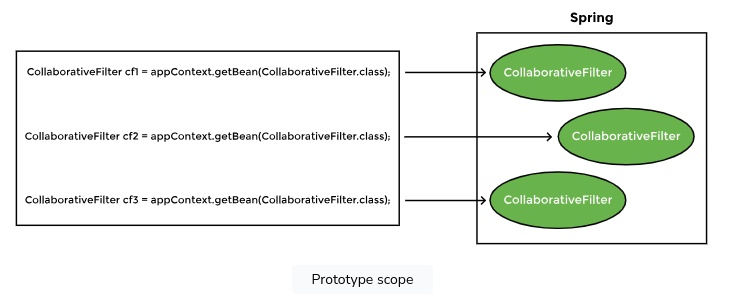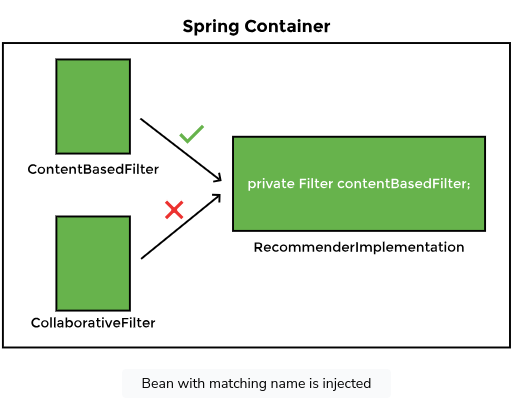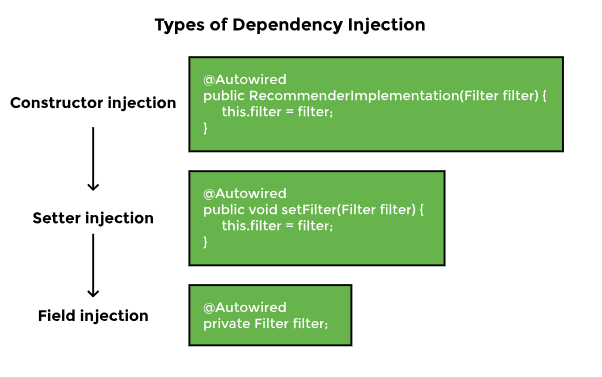autowiring by name and the @Primary annotation
are features that provide control over dependency
injection resolution when multiple beans of the same type are available:
@Component @Primary

@Autowired private Filter contentBasedFilter;
The @Qualifier annotation can be used in a scenario when we have multiple objects of the same type and autowiring by name cannot be used because the variable name doesn’t match any bean name
The @Qualifier annotation takes precedence over the @Primary annotation. To show this, let’s add the @Primary annotation to the ContentBasedFilter class and run the application
- Using field injection keeps the code simple and readable, but it is unsafe
- there are some differences between Constructor and setter injection. Setter injection is more readable as it specifies the name of the dependency as the method name but the number of setter methods increases with each increasing dependency increasing the boiler plate code. Setter injection is used to avoid the BeanCurrentlyInCreationException raised in case of a circular dependency
The Spring container manages beans. The term bean scope refers to the lifecycle and the visibility of beans. It tells how long the bean lives, how many instances of the bean are created, and how the bean is shared.
The default scope of a bean is singleton, in which only one instance of the bean is created and cached in memory.
Multiple requests for the bean return a shared reference to the same bean. In contrast, prototype scope results in the
creation of new beans whenever a request for the bean is made to the application context.


The prototype bean is injected into the singleton bean at the time of creation of the singleton bean when the container initializes it. This explains the following messages in the output:
ContentBasedFilter constructor called
Movie constructor called
The same instance of the bean is returned by the application context every time it is requested using the getMovie method. we can solve this problem with the PROXY for add indirection to get autowire and this happened when we add this " proxyMode=ScopedProxyMode.TARGET_CLASS" to scope annotation in the movie class.
Movie bean with prototype scope Movie constructor called io.datajek.spring.basics.movierecommendersystem.lesson9.Movie@4390f46e
this the output when we add proxy to scope annotation (we can solve this problem with @Lookup on getMovie function) Movie constructor called
io.datajek.spring.basics.movierecommendersystem.lesson9.Movie@7c6442c2
Movie constructor called
io.datajek.spring.basics.movierecommendersystem.lesson9.Movie@2d746ce4
- Spring does a component scan to search for the beans that it manages. In a Spring application, the **@ComponentScan ** annotation without any argument tells Spring to scan the current package as well as any sub-packages that might exist. Spring detects all classes marked with the @Component, @Repository, @Service, and @Controller annotations during component scan.
The @SpringBootApplication annotation is a combination of three annotations:
- @Configuration + @EnableAutoConfiguration + @ComponentScan
when we use this annotation spring searches the package where it is present, as well as all the sub-packages. If a bean is present in a package other than the base package or its sub-packages, it will not be found.
- @ComponentScan for specific package: @ComponentScan is used to specify the packages that should be scanned for Spring components, such as @Controller, @Service, and @Repository. By default, it scans the current package and its sub-packages. However, you can specify specific packages to be scanned using the basePackages attribute.
A method with this annotation works like the init method. The @PostConstruct annotation tells Spring to call the method for us once the object has been created. The method can have any name and its return type is always void. After the bean is created, we can initialize the contents of the bean, load data, establish a database connection, or connect to a web server. The post construct method is only called after all the dependencies have been populated.
this how this is going:
 By utilizing a logger object, we can capture important information during the execution of our Java application,
making it easier to debug and understand its behavior and for see the bean creation:
By utilizing a logger object, we can capture important information during the execution of our Java application,
making it easier to debug and understand its behavior and for see the bean creation:

The method having this annotation is called when the bean is in the process of being removed from the container. All
cleanup stuff can be performed in this method. A method with the @PreDestroy annotation can be used to release resources
or close a database connection.

Spring manages the entire lifecycle of singleton beans but it does not completely manage the lifecycle of prototype
beans. This is because there might be a large number of prototype instances and the container can become overwhelmed
keeping track of them.
 When the application terminates, the PreDestroy method is called for the singleton RecommenderImplementation bean (and
its dependency ContentBasedFilter bean) but not for the prototype scoped Movie bean.
When the application terminates, the PreDestroy method is called for the singleton RecommenderImplementation bean (and
its dependency ContentBasedFilter bean) but not for the prototype scoped Movie bean.

